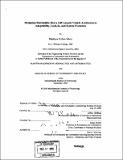| dc.contributor.advisor | Jeffrey Hoffman and Jaime Peraire. | en_US |
| dc.contributor.author | Silver, Matthew Robin | en_US |
| dc.contributor.other | Massachusetts Institute of Technology. Technology and Policy Program. | en_US |
| dc.date.accessioned | 2007-12-07T19:22:52Z | |
| dc.date.available | 2007-12-07T19:22:52Z | |
| dc.date.copyright | 2005 | en_US |
| dc.date.issued | 2005 | en_US |
| dc.identifier.uri | http://dspace.mit.edu/handle/1721.1/34143 | en_US |
| dc.identifier.uri | http://hdl.handle.net/1721.1/34143 | |
| dc.description | Thesis (S.M.)--Massachusetts Institute of Technology, Dept. of Aeronautics and Astronautics; and, (S.M.)--Massachusetts Institute of Technology, Engineering Systems Division, Technology and Policy Program, 2005. | en_US |
| dc.description | Includes bibliographical references (p. 147-150). | en_US |
| dc.description.abstract | Long term human space exploration depends on the development of a sustainable heavy lift launch vehicle (HLLV). But what exactly is sustainability in the context of launch systems and how can it addressed in the design process? A HLLV must balance myriad technical and programmatic factors such as performance, reliability, cost, geographical configuration, logistics and assembly, as well as in-space issues such as mass and manifesting requirements for Lunar and Mars missions, and rendezvous and docking capability. The problem is further complicated by uncertainties in demand and differing stakeholder incentives. The military significance of space launch creates security externalities that often constrain design; "standing armies" of technicians and operators throughout the country affect industry and political interests; and scientific goals are often at odds with all three. The multi-dimensional nature of the design problem suggests that sustainability is best addressed at the system architecture level, where direct links can be made between technical and non-technical aspects of system operation. This thesis examines the problem of designing sustainable heavy lift architectures in three ways: First, recent advances in systems architecture are synthesized as they apply to heavy lift launch. | en_US |
| dc.description.abstract | (cont.) Sustainability is defined more precisely, as are the counterbalancing dynamics of adaptability and architectural lock-in. Second, cases are studied to understand how the previously defined concepts have played out in practice. The evolution of system architectures leading to the development of the last heavy lift vehicle, Saturn V, is analyzed; and the problem of reducing cost in the modern launch industry is examined from a political-economic perspective. Finally, insights from these studies together with recent advances in engineering economy are used to develop quantitative models to compare architectures. An analytic model is created to evaluate mission cost and risk as a function of vehicle capacity and in-space requirements. A discrete model based on real-options thinking is developed to compare Space Shuttle-derived and Evolved Expendable Launch Vehicle (EELV) derived architectures. | en_US |
| dc.description.statementofresponsibility | by Matthew Robin Silver. | en_US |
| dc.format.extent | 150 p. | en_US |
| dc.language.iso | eng | en_US |
| dc.publisher | Massachusetts Institute of Technology | en_US |
| dc.rights | M.I.T. theses are protected by copyright. They may be viewed from this source for any purpose, but reproduction or distribution in any format is prohibited without written permission. See provided URL for inquiries about permission. | en_US |
| dc.rights.uri | http://dspace.mit.edu/handle/1721.1/34143 | en_US |
| dc.rights.uri | http://dspace.mit.edu/handle/1721.1/7582 | |
| dc.subject | Aeronautics and Astronautics. | en_US |
| dc.subject | Technology and Policy Program. | en_US |
| dc.title | Designing sustainable heavy lift launch vehicle architectures adaptability, lock-in, and system evolution | en_US |
| dc.type | Thesis | en_US |
| dc.description.degree | S.M. | en_US |
| dc.contributor.department | Massachusetts Institute of Technology. Department of Aeronautics and Astronautics | |
| dc.contributor.department | Massachusetts Institute of Technology. Engineering Systems Division | |
| dc.contributor.department | Technology and Policy Program | |
| dc.identifier.oclc | 67837360 | en_US |
